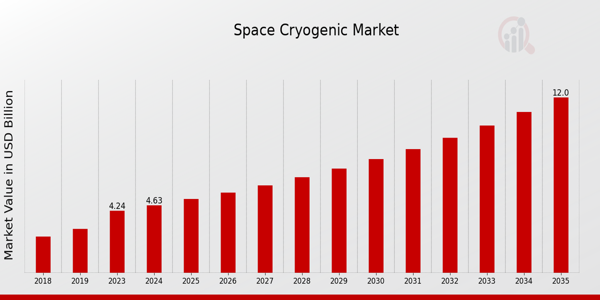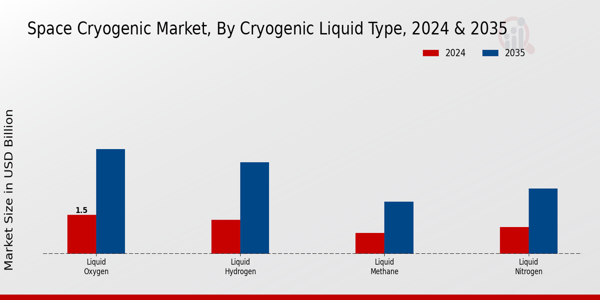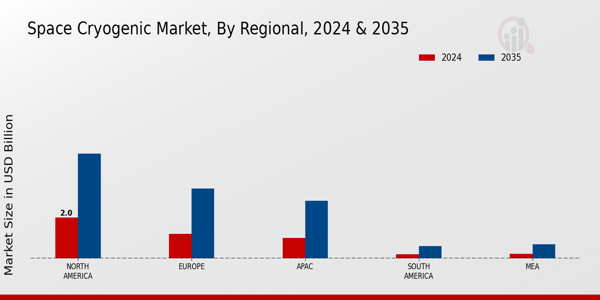Global Space Cryogenic Market Overview
As per MRFR analysis, the Space Cryogenic Market Size was estimated at 4.24 (USD Billion) in 2023.The Space Cryogenic Market is expected to grow from 4.63(USD Billion) in 2024 to 12.0 (USD Billion) by 2035. The Space Cryogenic Market CAGR (growth rate) is expected to be around 9.05% during the forecast period (2025 - 2035).
Key Space Cryogenic Market Trends Highlighted
A number of important variables are driving the noteworthy expansion of the global space cryogenic market. The need for sophisticated cryogenic technology is being driven by the growing demand for satellite launches and space exploration projects.
Globally, governments and commercial enterprises make significant investments in space missions, necessitating dependable and effective propulsion systems.
An increasing demand for cryogenic solutions in rocket propulsion, particularly in liquid hydrogen and oxygen fuels, is further highlighted by the increase in satellite-based applications, such as communication and earth observation.
Developments in cryogenic storage technologies and the possibility of increased launch system efficiency are two market opportunities that should be investigated.
As the space industry evolves, there is a strong focus on enhancing cryogenic logistics to support longer missions and deeper space exploration. Innovative solutions for cryogenic fuel handling and cryogenic component development present new avenues for growth.
The increasing collaboration between government agencies and private firms creates a fertile environment for joint ventures and partnerships aimed at developing cutting-edge cryogenic technologies.
Trends in recent times indicate a shift towards reusable launch vehicles, which can benefit from cryogenic capabilities for efficient fuel management. Furthermore, there is significant interest in sustainable space travel, prompting research into more environmentally friendly cryogenic fuels.
The rising focus on satellite internet provision and global connectivity also drives innovations in cryogenic technology. Overall, the Global Space Cryogenic Market is set to flourish, fueled by technological advancements, new opportunities, and an evolving landscape in space exploration and satellite deployment.

Source: Primary Research, Secondary Research, MRFR Database and Analyst Review
Space Cryogenic Market Drivers
Increasing Demand for Space Exploration
The Global Space Cryogenic Market is witnessing significant growth due to the increasing demand for space exploration activities. As countries and private companies invest heavily in missions beyond Earth's atmosphere, the need for advanced cryogenic technologies becomes critical.
Cryogenic systems play a vital role in the launch and operation of space vehicles, ensuring that propellants are maintained at ultra-low temperatures for optimal performance. The exploration of planets like Mars, as well as the potential for establishing permanent bases on celestial bodies, requires sophisticated cryogenic storage and handling solutions.
The expanding interests in not just governmental space missions but also commercial endeavors drive the need for reliable cryogenic technology. This push toward innovation in propulsion systems and the desire to maintain efficiency in fuel utilization calls for enhancements in the Global Space Cryogenic Market.
Furthermore, public interest and support for space missions remain high, encouraging investments and advancements that equip the industry with cutting-edge cryogenic solutions, reinforcing the role of cryogenics as a backbone of future space missions.
Additionally, as space agencies like NASA and ESA and private entities like SpaceX and Blue Origin ramp up their operations, the cascading effects on technology standards and requirements create an ecosystem ripe for continuous development and growth in the cryogenic sector.
Advancements in Cryogenic Technologies
Technological advancements in cryogenics are a significant driver for the Global Space Cryogenic Market. Continuous research and development efforts are leading to the creation of more efficient cryogenic systems, which not only enhance the performance of space vehicles but also reduce operational costs.
Innovations such as improved insulation materials, advanced cryogenic pumps, and smart monitoring systems help ensure that cryogenic fluids are stored and utilized effectively, further expanding the capabilities of space missions.
Growing Private Sector Participation
The burgeoning presence of private companies in the aerospace sector is driving growth in the Global Space Cryogenic Market. With increasing investments from private entities, there is a strong impetus to launch affordable and reusable space vehicles, which necessitates the use of advanced cryogenic technologies.
This shift fuels competition and innovation, leading to further developments and sophisticated solutions within the industry that meet the demands of both commercial and governmental spaceflight.
Space Cryogenic Market Segment Insights:
Space Cryogenic Market Cryogenic Liquid Type Insights
The Global Space Cryogenic Market segmented by Cryogenic Liquid Type revealed a significant landscape driven by key liquid forms that are critical for various aerospace applications.
The largest contributor within this segmentation was Liquid Oxygen, which is valued at 1.5 USD Billion in 2024 and projected to grow to 4.0 USD Billion by 2035. Its dominance can be attributed to its extensive use as an oxidizer in rocket propulsion systems, making it essential for reliable space exploration and satellite launches.
Following closely was Liquid Hydrogen, valued at 1.3 USD Billion in 2024, with future projections reaching 3.5 USD Billion in 2035. Being an efficient fuel source with a high specific impulse, Liquid Hydrogen was integral for many launch vehicles, reinforcing its significance in the market.
Liquid Methane, with a market valuation of 0.8 USD Billion in 2024 and an estimated increase to 2.0 USD Billion by 2035, represented an emerging player in the cryogenic sector. Its growing popularity was associated with advancements in technology, particularly with reusable rocket systems and missions to Mars, where methane is considered for in-situ resource utilization.
Liquid Nitrogen held a crucial position, with a valuation of 1.03 USD Billion in 2024, escalating to 2.5 USD Billion by 2035. Its role extended beyond propulsion; it was widely used in cryogenic cooling applications and as a propellant in certain launch vehicles, thus maintaining its relevance in the industry.
The overall Global Space Cryogenic Market data reflects not only the importance of these Cryogenic Liquid Types in operational capabilities but also the trends shaping the future of space exploration. Growing investments in space programs worldwide, alongside the increasing number of satellite launches, contributed significantly to market growth.
However, challenges such as technological advancement requirements and environmental considerations regarding resource extraction and utilization remain present. Nevertheless, opportunities abound, especially as the push for sustainable space travel intensifies, leading to an innovative exploration of new Cryogenic Liquid technologies that may reshape market dynamics moving forward.
Thus, the demand for a comprehensive understanding of the Global Space Cryogenic Market Statistics becomes essential for stakeholders navigating this evolving landscape.

Source: Primary Research, Secondary Research, MRFR Database and Analyst Review
Space Cryogenic Market Application Insights
The Global Space Cryogenic Market, particularly within the Application segment, is experiencing robust growth. This segment plays a pivotal role in various areas such as Rocket Propulsion, Space Exploration, Satellite Launch, and Scientific Research.
Rocket Propulsion remains a critical application, as it significantly enhances the efficiency and performance of launch vehicles, driving innovation in the sector. Space Exploration utilizes cryogenic technology to enable long-duration missions, providing essential cooling for instruments and payloads.
The Satellite Launch application showcases the increasing reliance on cryogenic fuels, which offer higher energy density than conventional options, thus improving payload delivery to orbit. Additionally, Scientific Research benefits from cryogenic systems, facilitating advanced experiments in space environments.
Overall, the Global Space Cryogenic Market segmentation reflects a dynamic industry that is driven by escalating demand for advanced space technologies, showcasing a promising path for innovation and development in the coming years.
Space Cryogenic Market End Use Insights
Major growth is anticipated across various End Use categories, which play critical roles in the advancement of space technology and exploration. The Government segment is key, as public investments and strategic missions often drive demand for cryogenic technologies, which are crucial for efficient propulsion systems and spacecraft cold storage.
The Commercial segment also represents a significant portion of the market, with private companies increasingly investing in space launches, satellite deployments, and research applications, thereby enhancing global competition.
Research Institutions further contribute to the market by developing innovative cryogenic technologies and facilitating advancements in material sciences and propulsion systems.
Overall, the integration of cryogenic technologies across these segments reflects the growing interest in space exploration and utilization, as encapsulated in the Global Space Cryogenic Market revenue and market growth statistics, signaling a robust landscape for investors and stakeholders in the coming years.
Space Cryogenic Market Storage Technology Insights
The Global Space Cryogenic Market, specifically within the Storage Technology segment, is experiencing a notable rise.
This segment includes essential components such as cryogenic tanks, insulated containers, and cryogenic pumps, which play critical roles in the effective storage and transportation of cryogenic substances. Cryogenic tanks are paramount as they facilitate the safe and efficient handling of liquefied gases at extremely low temperatures, which is vital for various space missions.
Insulated containers also hold significance as they help to maintain the required temperature thresholds, thus ensuring the integrity of the stored materials. Meanwhile, cryogenic pumps dominate in enabling the transfer of cryogenic fluids, making operations efficient.
The combination of these components supports the increasing demand for advanced space solutions. The market growth in this segment is driven by expanding space exploration activities and technological advancements, though challenges such as high manufacturing costs persist.
Nevertheless, opportunities abound in developing innovative storage solutions to enhance operational efficiency in the Global Space Cryogenic Market, as reflected in its robust statistics and projected growth trajectory.
Space Cryogenic Market Regional Insights
The Regional segment of the Global Space Cryogenic Market showed considerable potential, with the market expected to reach notable values in the coming years. In 2024, North America held a majority share at 2.0 USD Billion, reflecting strong investments in aerospace and defense technologies, while it is expected to grow to 5.1 USD Billion by 2035.
Europe followed closely, valued at 1.2 USD Billion in 2024 and expected to expand to 3.4 USD Billion, indicating its significant role in cryogenic technology developments. The APAC region, starting at 1.0 USD Billion in 2024 and growing to 2.8 USD Billion, became increasingly important due to advancements in satellite manufacturing and space exploration.
South America and the MEA regions demonstrated smaller market values, with South America at 0.2 USD Billion and MEA at 0.23 USD Billion in 2024, but both are anticipated to grow steadily, reaching 0.6 USD Billion and 0.7 USD Billion respectively by 2035.
These dynamics revealed the competitive landscape where North America and Europe dominate, driven by their established space infrastructure and funding, while APAC emerged as a future growth leader, underlining the diverse opportunities within the Global Space Cryogenic Market.

Source: Primary Research, Secondary Research, MRFR Database and Analyst Review
Space Cryogenic Market Key Players and Competitive Insights:
The Global Space Cryogenic Market is a burgeoning field that plays a vital role in the advancement of space exploration and technology.
With the increased interest in exploring deep space and launching satellites, cryogenic systems have gained significant attention due to their ability to store and manage cryogenic fluids, which are essential for powering rockets and maintaining scientific experiments in extreme environments.
The competitive landscape in this market is characterized by both established aerospace agencies and innovative startups, each contributing to the evolution of cryogenic technologies and applications.
Companies are focusing on enhancing efficiency, reducing costs, and improving the reliability of cryogenic storage and transport systems, thus positioning themselves strategically in this dynamic industry.
NASA is a key player in the Global Space Cryogenic Market, leveraging its extensive experience and technological capabilities to take significant strides in cryogenic propulsion systems and storage solutions. With a plethora of ongoing projects, NASA has established a robust infrastructure for handling cryogenic fuels, implementing innovation in super cooled propellant technologies.
The agency's strengths lie in its research and development prowess, which aids in pushing the boundaries of current cryogenic applications. NASA's historical achievements in space exploration also imbue a level of trust and reliability in its technologies, attracting partnerships and collaborations that further enhance its presence in the market.
The agency's commitment to sustainability and efficiency in cryogenic systems aligns with the growing demands of the space sector, thereby solidifying NASA's status as a leader in this field. Rocket Lab continues to make significant contributions to the Global Space Cryogenic Market with its innovative and agile approach to technology development.
Primarily known for its Electron rocket, Rocket Lab has integrated cryogenic systems into its launch operations to maximize payload capacity and enhance performance. The company's strengths are rooted in its dedicated focus on miniaturized satellite launches, which require effective cryogenic solutions to maintain optimal performance.
Rocket Lab's advanced manufacturing processes allow for rapid production and deployment of cryogenic technologies, making them a formidable competitor in the market. Furthermore, their commitment to lowering launch costs without compromising quality has positioned Rocket Lab as a formidable challenger in the evolving landscape of space exploration and satellite deployment.
Rocket Lab's ability to innovate and adapt quickly allows it to maintain a dynamic presence in the competitive space cryogenic arena.
Key Companies in the Space Cryogenic Market Include:
- NASA
- Rocket Lab
- Universal Space Network
- Praxair Technology
- MBD Energy
- Aerojet Rocketdyne
- Cryofab
- Air Liquide
- Chart Industries
- Blue Origin
- Sierra Nevada Corporation
- Northrop Grumman
- Relativity Space
- SpaceX
- Linde
Space Cryogenic Market Developments
Recent developments in the Global Space Cryogenic Market have seen significant advancements, particularly with companies like NASA and SpaceX, which continue to enhance cryogenic technologies for rocket propulsion systems. Rocket Lab has also made strides, launching new missions that rely on improved cryogenic fueling methodologies.
Universal Space Network is expanding its capabilities, focusing on providing enhanced support for cryogenic satellites, thereby bolstering operational efficiency in the field. In terms of mergers and acquisitions, Air Liquide has recently completed the acquisition of a majority stake in Chart Industries, a move aimed at strengthening its position in cryogenic technology and applications.
Additionally, Northrop Grumman's ongoing research and development investments are significantly impacting the market's growth trajectory, allowing for innovative cryogenic storage solutions. Companies like Linde are witnessing strong market valuation growth due to increasing demand for liquefied gases essential for space exploration.
The overall impact of these developments is reflected in an increasingly competitive landscape, where the need for advanced cryogenic systems fuels innovation and investment across multiple stakeholders, including Aerojet Rocketdyne, Blue Origin, and Sierra Nevada Corporation.
Space Cryogenic Market Segmentation Insights
Space Cryogenic MarketCryogenic Liquid TypeOutlook
- Liquid Oxygen
- Liquid Hydrogen
- Liquid Methane
- Liquid Nitrogen
Space Cryogenic MarketApplicationOutlook
- Rocket Propulsion
- Space Exploration
- Satellite Launch
- Scientific Research
Space Cryogenic MarketEnd UseOutlook
- Government
- Commercial
- Research Institutions
Space Cryogenic MarketStorage TechnologyOutlook
- Cryogenic Tanks
- Insulated Containers
- Cryogenic Pumps
Space Cryogenic MarketRegionalOutlook
- North America
- Europe
- South America
- Asia Pacific
- Middle East and Africa
|
Report Attribute/Metric
|
Details
|
|
Market Size 2023
|
4.24(USD Billion)
|
|
Market Size 2024
|
4.63(USD Billion)
|
|
Market Size 2035
|
12.0(USD Billion)
|
|
Compound Annual Growth Rate (CAGR)
|
9.05% (2025 - 2035)
|
|
Report Coverage
|
Revenue Forecast, Competitive Landscape, Growth Factors, and Trends
|
|
Base Year
|
2024
|
|
Market Forecast Period
|
2025 - 2035
|
|
Historical Data
|
2019 - 2024
|
|
Market Forecast Units
|
USD Billion
|
|
Key Companies Profiled
|
NASA, Rocket Lab, Universal Space Network, Praxair Technology, MBD Energy, Aerojet Rocketdyne, Cryofab, Air Liquide, Chart Industries, Blue Origin, Sierra Nevada Corporation, Northrop Grumman, Relativity Space, SpaceX, Linde
|
|
Segments Covered
|
Cryogenic Liquid Type, Application, End Use, Storage Technology, Regional
|
|
Key Market Opportunities
|
Increased satellite launches, Advancements in cryogenic technology, Growing demand for space exploration, Rising investments in space missions, Expansion of private space industry
|
|
Key Market Dynamics
|
Increasing demand for space exploration, Advancements in cryogenic technology, Growing satellite launches, Rising investment in the aerospace sector, Stringent regulations for cryogenic fluids
|
|
Countries Covered
|
North America, Europe, APAC, South America, MEA
|
Frequently Asked Questions (FAQ) :
The Global Space Cryogenic Market is expected to be valued at 4.63 USD Billion in 2024.
By 2035, the Global Space Cryogenic Market is projected to reach a valuation of 12.0 USD Billion.
The Global Space Cryogenic Market is expected to grow at a CAGR of 9.05% from 2025 to 2035.
In 2024, North America is expected to hold the largest market share, valued at 2.0 USD Billion.
The market value for Liquid Oxygen in 2024 is projected to be 1.5 USD Billion.
Major players in the Global Space Cryogenic Market include NASA, SpaceX, and Blue Origin.
The projected market value for Liquid Nitrogen in 2035 is 2.5 USD Billion.
The estimated market size for Liquid Methane in 2024 is valued at 0.8 USD Billion.
The expected market value for the APAC region by 2035 is projected to be 2.8 USD Billion.
The South American segment is expected to grow to a value of 0.6 USD Billion by 2035.

















